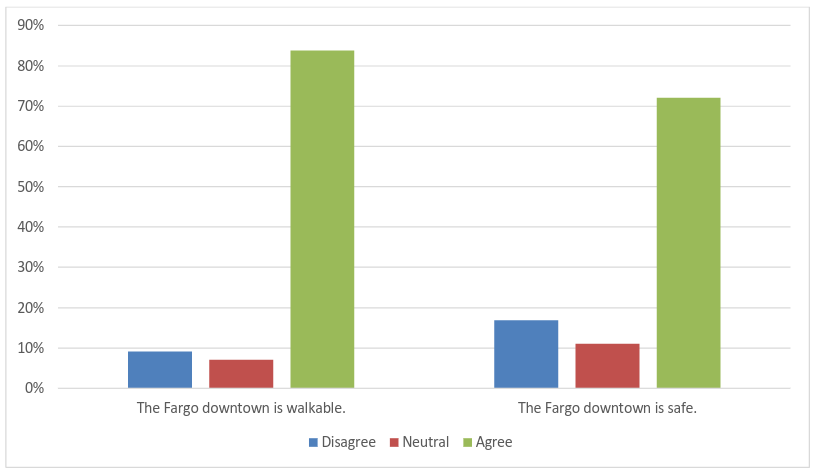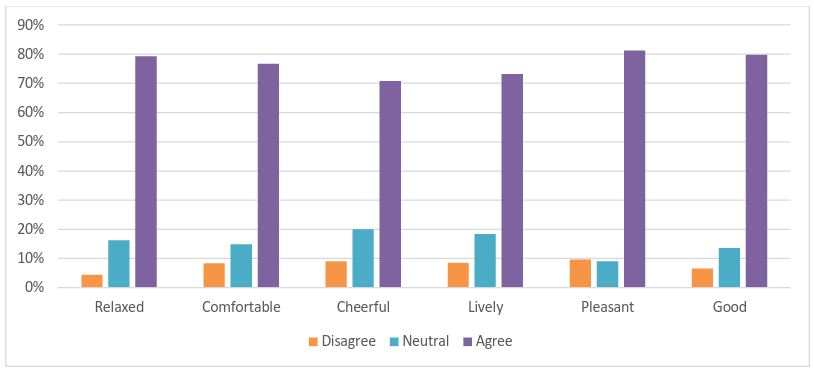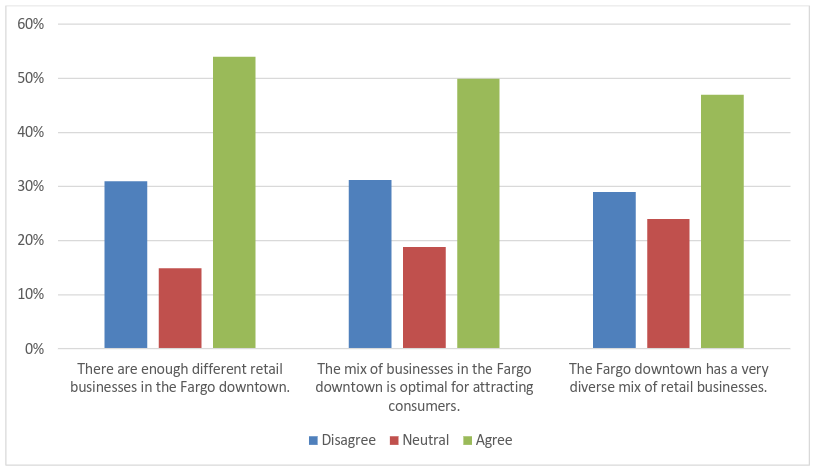 |
April 2017
|
April 2017 // Volume 55 // Number 2 // Research In Brief // v55-2rb7
Determinants of Downtown Image and Retail Patronage: A Case of Fargo, North Dakota
Abstract
We sought to identify determinants of downtown image and retail patronage, which contribute to tourism development in small and mid-sized communities. The purpose of our research was twofold: (a) to understand how visitors perceive the business mix, safety, and atmosphere of the Fargo, North Dakota, downtown and (b) to identify what factors influence their perceptions of the downtown and patronage of the downtown retail businesses. A total of 155 visitors to Fargo's downtown participated in our survey. Although we investigated one specific downtown, our findings may be relevant to Extension professionals in other small and mid-sized cities.
Introduction
A downtown can be an important asset for a community's economy, especially in small and mid-sized cities. Tourism is a significant contributor to the economies of small and mid-sized cities (Runyan, 2006), and their downtowns play the role of tourist destination, providing architecturally interesting buildings, unique products, and cultural events. Thus, a strong retail presence in the downtown is essential for the economic viability of small and mid-sized cities (Robertson, 1999). In addition, a downtown is home to small and local businesses, which contribute money to local economies.
In spite of the importance of downtowns, retail businesses in downtowns have struggled for years due to the development of shopping malls and multichannel retailers outside city centers. Because economic development is likely to be successful if Extension professionals initiate it at the local level (Connell & Wall, 2004), a priority for Extension professionals in small or mid-sized cities is enhancing retail vitality of downtowns. The Center for Community Vitality at North Dakota State University provides practical research, university connections, and other relevant resources for vitalizing communities in North Dakota. In this vein, we sought to provide Extension professionals with information for developing strategies for enhancing retail vitality of downtowns by identifying determinants of downtown retail patronage.
Specifically, our intent was to gain insights about the downtown of Fargo, North Dakota. The most populous city in North Dakota, Fargo falls into the category of "small to mid-sized city"; the estimated population as of 2015 was 118,523 ("Fargo, North Dakota," n.d.). As such, its downtown can be important as a tourist destination. Accordingly, the purpose of our research was twofold: (a) to understand how visitors perceive the business mix, safety, and atmosphere of the Fargo downtown and (b) to identify what factors influence their perceptions of the Fargo downtown and patronage of retail businesses in the Fargo downtown. Extension professionals in Fargo may be able to use our findings to help community developers attract more visitors to the downtown and improve the economic performance of the downtown. In addition, Extension professionals in other small and mid-sized cities may be able to make use of the results as well.
Tourists' and local consumers' decisions about whether to shop and dine in a downtown are determined by the image of the downtown (Runyan, 2006). Moreover, a relationship exists between positive image and patronage behaviors, such as shopping frequency and loyalty (Hunter, 2006). Various aspects of a downtown can determine the downtown's image and, in turn, influence downtown retail patronage. First, business mix is considered a key factor of downtown attractiveness (Teller, 2008). Diverse retailers can attract people to the downtown, providing value-added consumer experiences that can be offered by a good mix of small businesses, such as retail, hospitality, and tourism establishments (Fiore, Niehm, Oh, Jeong, & Hausafus, 2007). Other characteristics, such as safety and atmosphere, are known to be contributors to a downtown's image and retail patronage (Baker, Grewal, & Parasuraman, 1994; Runyan, 2006). "Safe and walkable community" was selected as one of the top qualities people wanted in small or medium-sized communities (Michigan Cool Cities Initiative, 2003). In addition, consumers may feel comfortable with the downtown district when the downtown is perceived as a pleasant place to visit (Runyan, 2006). Thus, a pleasant atmosphere would draw more consumers to a downtown.
Methods
Using convenience sampling, we recruited 155 downtown visitors in Fargo, North Dakota, to participate in a survey. Downtown visitors were intercepted in various downtown locations and asked to complete the survey. Due to the nature of downtown's residence types (e.g., loft/studio apartments or single-room condos) and attractions (modern bars, casual restaurants, coffee shops, etc.), the sample comprised relatively younger visitors.
Survey participants indicated level of agreement with statements related to perceptions of the business mix, safety, atmosphere, and image of the Fargo downtown and intention to patronize the Fargo downtown (e.g., "I intend to come back to the Fargo downtown for shopping in the near future") by using a 7-point Likert scale ranging from 1 (strongly disagree) to 7 (strongly agree). The measurements on the questionnaire were adapted from previous literature and modified to fit the research.
We conducted descriptive analyses and performed stepwise multiple regression analyses to test various relationships relative to perceived business mix, safety, atmosphere, image of the downtown, and intention to patronize downtown retail businesses. All 155 responses were used in the regression.
Findings
A majority of the survey participants were female (64%), and most were under 35 years of age (84%). Participants reported that they shopped downtown two times or more a week (4.0%), once a week (12.1%), once every 2 weeks (10.5%), once a month (17.7%), once every 2 months (21.0%), three or four times a year (17.7%), one or two times a year (10.5%), and less than once a year (6.5%). Average spending for the respondents' most recent downtown shopping trip was $48.
Overall, participants' perceptions of the safety of the Fargo downtown were positive. Most participants perceived the Fargo downtown as walkable (83.8%) and safe (72.1%). See Figure 1.
Figure 1.
Perceptions of the Safety of the Fargo, North Dakota, Downtown

Participants also had positive perceptions of the atmosphere of the Fargo downtown. For example, most of the participants considered the atmosphere of the Fargo downtown to be pleasant (81.2%), good (79.9%), relaxed (79.3%), comfortable (76.7%), lively (73.2%), and cheerful (70.8%). See Figure 2.
Figure 2.
Perceptions of the Atmosphere of the Fargo, North Dakota, Downtown

Compared to how they felt about the safety and atmosphere of the Fargo downtown, respondents were less enthusiastic about its business mix. That is, a relatively smaller proportion of participants evaluated the business mix of the Fargo downtown positively. See Figure 3.
Figure 3.
Perceptions of the Business Mix of the Fargo, North Dakota, Downtown

We performed stepwise regression analyses to determine whether certain factors were associated with respondents' image of the downtown and intention to patronize downtown retail businesses. Perceptions of safety, atmosphere, and business mix were included as independent variables in the stepwise regression analyses. In addition, gender and marital status were included as control variables in the regression models. The stepwise regression analyses ultimately excluded the control variables as they were insignificant in both models. Visitors' perceptions of the safety, atmosphere, and business mix of the downtown were positively related to perceptions of the image of the downtown. Perception of safety was the strongest influence (β = .362, p < .001), followed by perception of atmosphere (β = .295, p < .001) and then perception of business mix (β = .206, p = .004). Intention to patronize downtown retail businesses was influenced by perception of amosphere (β = .528, p < .001) and perception of business mix (β = .216, p = .002), with perception of atmosphere being the stronger influence. Perception of safety of the downtown did not significantly influence intention to patronize downtown retail businesses. See Table 1 for results of the stepwise regression analyses involving the safety, atmosphere, business mix, gender, and marital status variables. Lastly, we found that perceived image of the downtown affected intention to patronize the downtown retail businesses. Pearson correlation between perceived image of the downtown and intention to patronize the downtown retail businesses was .488 (p < .001).
| Dependent variable | Safety | Atmosphere | Business mix | Gendera | Marital statusa | R | R2 | F |
| Perceived image of downtown | .362 | .295 | .206 | .062 | −.025 | .632 | .400 | 33.048 |
| Intention to patronize downtown retail businesses | .103 | .528 | .216 | .008 | −.067 | .650 | .422 | 54.749 |
| aControl variable. | ||||||||
Conclusions
We sought to identify determinants of downtown image and retail patronage, which contribute to tourism development of small and mid-sized communities. Moreover, because tourism development is a complex process that requires interdisciplinary efforts (Honadle, 1990), we combined our perspectives from different disciplines—retail merchandising and tourism management—in a research collaboration intended to help Extension professionals develop interdisciplinary programming. Although we investigated one specific downtown, our findings may be relevant to Extension professionals in other small and mid-sized cities.
Relative to Fargo specifically, findings of our research detailed in the list below can help Extension professionals develop strategies and programs for retail vitality of the Fargo downtown.
- Visitors to the Fargo downtown positively perceived the safety of the downtown. In addition, perceived safety of the Fargo downtown was positively associated with perceived image of the Fargo downtown.
- Visitors to the Fargo downtown positively rated its atmosphere. The stimulating and lively atmosphere of the Fargo downtown encouraged visitors to come back and to shop or dine there.
- Visitors' perception of business mix was found to be associated with their intention to patronize downtown retail businesses; however, not many visitors positively evaluated the business mix of the Fargo downtown. This finding points to the need for a broader range of goods and stores in the Fargo downtown to increase retail patronage there. For the Fargo downtown to compete with shopping malls and national chain stores, an optimal mix of diverse and unique businesses is critical.
- A moderate portion of the visitors indicated that there are not enough different businesses to attract shoppers to the Fargo downtown. To increase local business, Extension professionals can encourage entrepreneurship in the community. Partnerships with various local organizations, such as small business development centers and chambers of commerce, would create synergy in the effort (Howe, Hines, & Nelson, 2005).
- Future research is needed to help Extension professionals understand what types of retailers could be added to the current business mix of the Fargo downtown to attract more visitors.
The sample drawn for our study precludes strong generalization of the results to a broader population as we used convenience sampling. Identifying how the relationships we identified generalize to other populations should be the next step in this research agenda (Cook & Campbell, 1979). However, findings of the research might be applicable to other small and mid-sized cities because they are supported by previous studies. Consequently, Extension professionals in other small and mid-sized cities may be able to make use of results from our study. For example, both perceived image of a downtown and intention to patronize downtown businesses contribute to the success of downtowns, and we found that in the case of Fargo, perceived safety, atmosphere, and business mix were positively associated with either perceived image of the downtown or intention to patronize downtown retail businesses. In other studies, similar factors have been identified as influences on the success of downtowns. Filion, Hoernig, Bunting, and Sands (2004) surveyed planners and other urban professionals from the United States and Canada to determine factors in the success of small downtowns. Active retail scene, pedestrian environment, cultural activities, street-oriented retail, and people on sidewalks were the five most important factors (Filion et al., 2004). This finding supports results of our study as all the successful factors are closely related to safety (e.g., pedestrian environment), atmosphere (e.g., cultural activities), and business mix (e.g., active retail scene). Similarly, policy makers in small cities in the United States also identified safety from crime, pedestrian safety, cultural opportunities, tolerance of diversity, and availability of restaurants as perceived strengths of their downtowns (Bias, Leyden, & Zimmerman, 2015).
Several implications for governments and planners of small downtowns can be identified on the basis of our research and previous studies. Small downtowns need to be safe pedestrian environments so that people perceive them as walkable. Recreational activities and events that improve the atmosphere of a downtown are necessary for the success of small downtowns. Diversity of retail options, including restaurants, strengthens small downtowns. Grunwell and Ha (2014) identified recreation, special events, and restaurants as top attractions enticing people to visit small downtowns. Moreover, in two other surveys related to small or mid-sized cities, restaurants were identified as a primary draw for visitors to downtowns and as retail businesses that downtown visitors are most likely to purchase from ("Downtown Boulder," 2014; "Downtown Leavenworth," 2015). In addition, gift shopping and supporting local businesses were identified as other primary reasons for visiting downtowns. Thus, gift shops that carry unique local products would be a good addition to a downtown business mix. Extension professionals outside Fargo may consider these factors when assisting communities in development efforts.
References
Baker, J., Grewal, D., & Parasuraman, A. (1994). The influence of store environment on quality influences and store image. Journal of the Academy of Marketing Science, 22(4), 328–339.
Bias, T. K., Leyden, K. M., & Zimmerman, J. (2015). Exploring policy-maker perceptions of small city downtowns in the USA. Planning Practice & Research, 30(5), 497–513.
Connell, D. J., & Wall, E. (2004). Profiling economic capacity. Journal of Extension, 42(4), Article 4FEA2. Available at: https://www.joe.org/joe/2004august/a2.php
Cook, T. D., & Campbell, D. T. (1979). Quasi experimentation: Design and analytical issues for field settings. Chicago, IL: Rand McNally.
Downtown Boulder User Survey. (2014). Retrieved from City of Boulder Colorado website: https://www-static.bouldercolorado.gov/docs/DT_Boulder_User_Report_2014_nov_mtg-1-201601061510.pdf
Downtown Leavenworth Shopping Survey. (2015). Retrieved from City of Leavenworth Kansas website: http://www.lvks.org/egov/documents/1433971324_58791.pdf
Fargo, North Dakota. (n.d.). In Wikipedia. Retrieved September 2, 2016, from https://en.wikipedia.org/wiki/Fargo,_North_Dakota
Filion, P., Hoernig, H., Bunting, T., & Sands, G. (2004). The successful few: Healthy downtowns of small metropolitan regions. Journal of the American Planning Association, 70(3), 328–343.
Fiore, A. M., Niehm, L., Oh, H., Jeong, M., & Hausafus, C. (2007). Experience economy strategies: Adding value to small rural businesses. Journal of Extension, 45(2), Article 2IAW4. Available at: https://www.joe.org/joe/2007april/iw4.php
Grunwell, S., & Ha, I. S. (2014). How to revitalize a small rural town? An empirical study of factors for success. University-community collaboration with a small historic rural tourism town. Journal of Rural and Community Development, 9(2), 32–50.
Honadle, B. W. (1990). Extension and tourism development. Journal of Extension, 28(2), Article 2FEA1. Available at: https://www.joe.org/joe/1990summer/a1.php
Howe, S., Hines, S., & Nelson, J. (2005). Teaching entrepreneurial management skills to Extension audiences. Journal of Extension, 43(2), Article 2TOT6. Available at: https://www.joe.org/joe/2005april/tt6.php
Hunter, G. L. (2006). The role of anticipated emotion, desire, and intention in the relationship between image and shopping center visits. International Journal of Retail and Distribution Management, 34(10), 709–721.
Michigan Cool Cities Initiative. (2003). Retrieved from Michigan.gov. website: https://www.michigan.gov/documents/mdcs/KGagnonStrategicWorkforcePlanningSummit_254965_7.pdf
Robertson, K. A. (1999). Can small-city downtowns remain viable? Journal of the American Planning Association, 65(3), 270–283.
Runyan, R. C. (2006). Tourist dependent small towns: Understanding competitive advantage. Journal of Vacation Marketing, 12(4), 329–343.
Teller, C. (2008). Shopping streets versus shopping malls—Determinants of agglomeration format attractiveness from the consumers' point of view. International Review of Retail, Distribution and Consumer Research, 18(4), 381–403.




